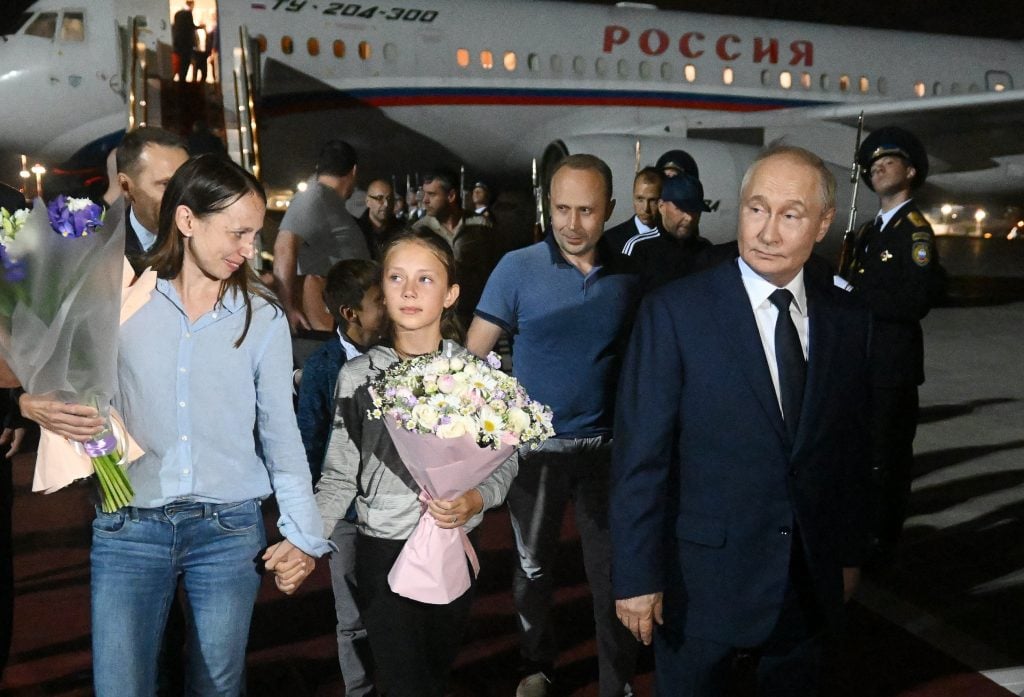Law & Politics
One of the Russian Spies Just Sent Back to Moscow? She Posed as an Art Dealer in Slovenia
Anna Dultseva was one of 26 people who returned home in a prisoner exchange between Russia and the West.

Anna Dultseva was one of 26 people who returned home in a prisoner exchange between Russia and the West.

Brian Boucher

Anna Dultseva, one of the four Russian agents returned to Moscow in an August 1 prisoner exchange, had led her life since 2017 playing the part of Maria Rosa Mayer Munos, an Argentinian art dealer. In fact, she was reporting to Russia’s foreign intelligence agency, the SVR.
5’14 Art Gallery’s website appears to have gone offline, but its Instagram, with about 10,000 followers, remains. Recent posts include works by South Korean artists Karis Kim and Pil Ryu, Slovakian painter Igor Navotsky, and the Netherlands’s Mariken Heijwegen.
Slovenian curator Tevz Logar told the New York Times that the gallery’s poor quality offerings (“the kind of art you order from China”) and disastrous finances (five-digit losses in 2019 and three- to four-digit profits in the following two years) should have caused the authorities to ask questions, but said that the Slovenian art world “is a safe space” because “there is no scrutiny or control.”
Indeed, Damian Kosec, founder and director of the SLOART Gallery and Auction House, in Ljubljana, told the Times that “there is so little money in [art] in Slovenia that nobody in the government pays attention to it.”
If Dultseva was a poor art dealer, she does seem to have fooled her children in addition to her artists. The Kremlin said that even 12-year-old daughter Sofia and nine-year-old son Gabriel did not know that their parents were spies (and, in fact, in press photos, they do not look overjoyed to be arriving in Moscow). The children speak only Spanish, their parents’ supposed native tongue, and Putin greeted them at the airport by saying “buenas noches.” Kremlin spokesman Dmitry Peskov revealed that the children asked their parents who was greeting them, not knowing who Putin is.
Heijwegen, the Dutch artist, sold two works via Dultseva, whom she met at an art fair in Croatia. “She looked like an Argentine,” Heijwegen told the Times, adding that she was “very sweet and kind.” Only when her unsold paintings were returned to her did she learn about her dealer’s true occupation.
Dultseva and her husband had served without diplomatic or other official cover that would have afforded them immunity if apprehended. Undercover agents, or “illegals,” assume other professional identities. Her husband, Artem Dultsev, lived as Ludwig Gisch, an Argentine owner of a high-tech startup, DSM & IT. The couple were arrested in 2022 at their home in the suburbs of Ljubljana, when the authorities, operating on a tip from another intelligence agency, raided the family’s home.
They were part of a complicated prisoner exchange between Russia and several European nations that saw 26 imprisoned Americans, Russians, and Europeans return home; the thorny negotiations had stretched over a year. (Also included in the swap was Russian dissident artist Alexandra Skochilenko, who had created works protesting Russia’s war in Ukraine.)
Just before their release, they pleaded guilty to spying charges and were sentenced to 19 months in prison each, but they were released on time served when returned to Russia.
Sources told the New York Times that the tip had come from Britain, where Dultseva had organized two exhibitions and traveled several times.
Dultseva hadn’t fooled everyone, or at least not quite. Kiain Balloch, a wedding photographer from Scotland, paid a small fee to submit some of her more artistic efforts to a contest run by Dultseva. “I did worry that I was throwing money into a scam,” she told the Times of London. “But it turns out that the reality was way, way more wild.”